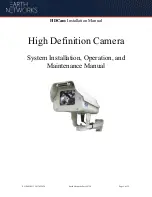
29
Audio Signal Block
Overview
The purpose of this section is to discuss the three different audio paths.
The three paths are D8 record, D8 playback and analog 8mm playback.
We will discuss this in block level only since component troubleshooting is
not necessary. The connectors will help to determine if the failure is on
the VC-213 board or not.
D8 Record
Recording can be done either by using the signal from the camera mic
audio, analog audio line input or through the IEEE1394 input. The
camcorder can record audio in 12-bit or 16-bit modes. The frequency
response of the 12-bit mode is limited, but you have greater editing capa-
bilities because insert editing is possible. The sampling rates used are 32
kHz for 12-bit mode and 48kHz for 16-bit mode. There is also a 44 kHz
sampling mode in the DV standards. The 1999 D8 models do not record
in this mode, but they will playback a tape that contains this type of 16-bit
audio. The Audio Check tape (WR5-3ND) can be used to check all three
modes during playback.
In record, the switch block can be used to switch between the Line In and
the Mic inputs. If the Mic input is used, it is amplified in this IC. Whichever
audio signal is chosen is output to the IR Transmitter and the ADC/DAC
blocks.
The IR transmitter modulates the audio and video signals it receives and
transmits them through the air using the LEDs on the front of the camcorder.
The audio input is converted to a digital signal by the ADC section of the
block. The signal is then sent to the DSP/Compression stage to be pro-
cessed.
The DSP/Compression block interleaves the audio data with the video
data. Once this is done, the audio signal follows the same path as the
video signal until it is put on the tape by the video heads. Keep in mind
that the audio signal is not compressed. Its data is only interleaved with
the video data. It is also sent along with the video to the IEEE1394 inter-
face.
D8 Playback
When the heads read the signal, it first goes to the Head Amp. This signal
contains audio and video information that is interleaved together. The
DSP/Decompression block processes this signal. This block sends the
signal to the IEEE1394 interface. It also deinterleaves the audio and
video signals. The audio signal is output to ADC/DAC block where it is
converted back to analog. The analog audio signal is passed to the Switch-
ing (ABC), which outputs it to the speaker, line out and IR Transmitter IC.
Analog 8mm Playback
The signal from the heads is applied to the Head Amp, which amplifies
and outputs the RF signal. The signal is then applied to the 8mm AFM
Processing Block. This block extracts the audio signals from the RF.
This signal is applied to the Switching block (ABC). This block outputs the
audio signals to the speaker, line out and IR Transmitter. This block also
outputs the audio signal to the ADC/DAC block. The signal is digitized
and sent through the D8 record signal path so that it can be output from
the IEEE1394 connector.
Summary of Contents for D8MM-01
Page 1: ...Training Manual Circuit Description and Troubleshooting Course D8MM 01 Digital Camcorder S ...
Page 4: ...2 NOTES ...
Page 18: ...16 ...
Page 20: ...18 ...
Page 22: ...20 ...
Page 24: ...22 ...
Page 26: ...24 ...
Page 28: ...26 ...
Page 30: ...28 ...
Page 32: ...30 ...
Page 34: ...32 ...
Page 36: ...34 ...
Page 44: ...42 ...














































